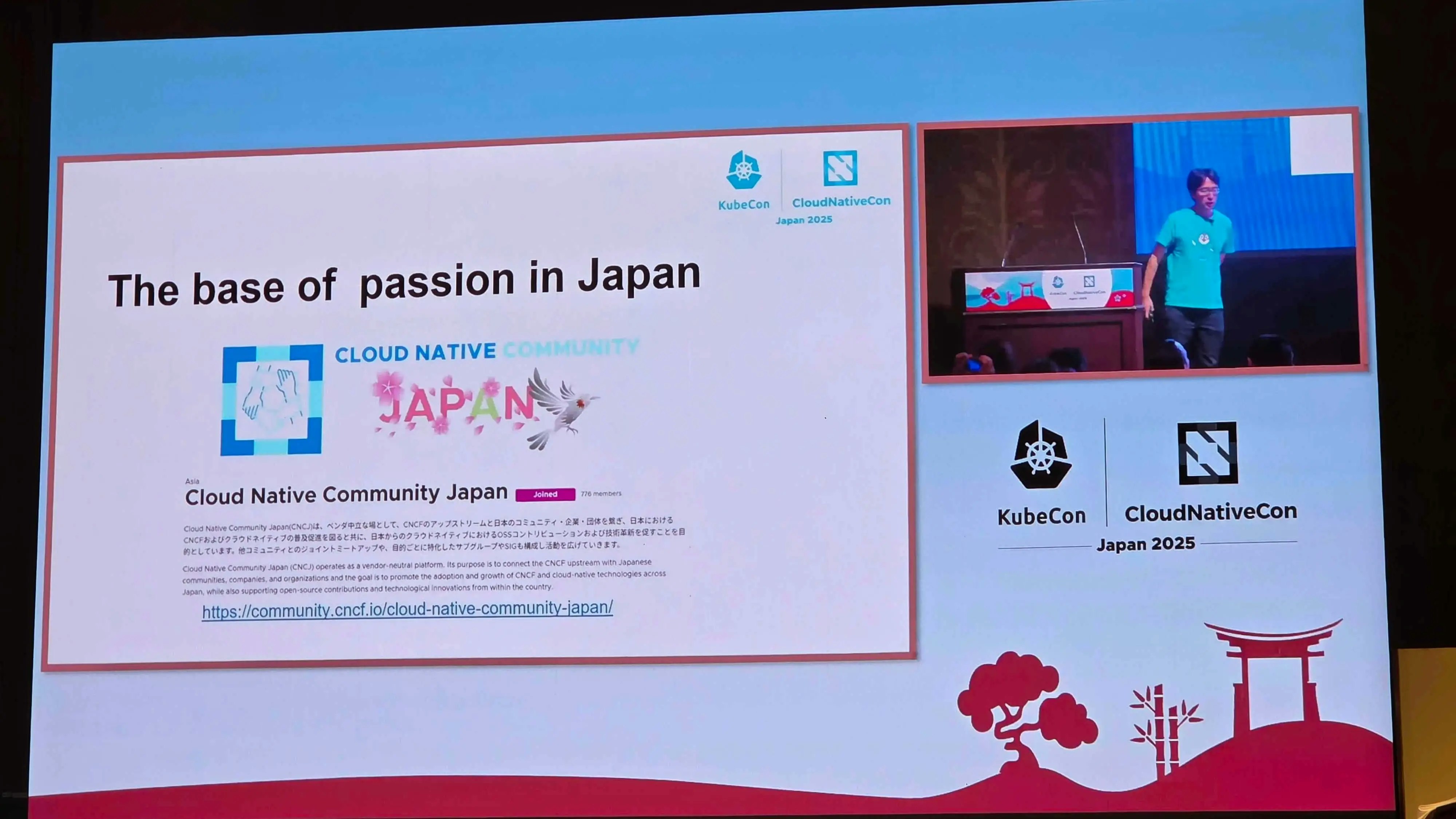KubeCon + CloudNativeCon Japan 2025: Cloud-Native is Just Getting Started
A sold-out conference reveals an industry in transformation—from edge computing to AI platforms, the cloud-native journey has only just begun.
A sold-out conference reveals an industry in transformation—from edge computing to AI platforms, the cloud-native journey has only just begun.
KubeCon + CloudNativeCon Japan 2025 was declared sold out before the doors opened. Every seat filled, every hallway buzzing with conversations about the future of infrastructure. After three days in Tokyo, one thing became crystal clear: we're not witnessing the maturation of cloud-native—we're seeing its true beginning.
Walking the conference halls, you couldn't escape a fundamental shift happening in how we think about computing. Kubernetes is no longer just for web applications. It's becoming the universal control plane for everything.
PlayStation Network operates 50+ Kubernetes clusters, achieving 99.995% availability. Sony's presentation showed how they've built their entire gaming infrastructure on Kubernetes, complete with Agones—their open-source platform for hosting dedicated game servers. When gaming giants are betting their user experience on Kubernetes, you know we've crossed a threshold.
Tokyo Gas won the CNCF End User Case Study Contest for their Kubernetes and Istio deployment. A century-old utility company is running cloud-native infrastructure with service mesh. If traditional industries are embracing Kubernetes for critical infrastructure, the transformation is deeper than most realize.
The message is clear: Kubernetes has evolved from a container orchestrator to the platform for modern computing.
One of the most surprising themes was the emphasis on Japanese companies contributing back to open source. The "Spirit of Wa" keynote showcased this beautifully:
Line Yahoo open-sourced Vald - a highly scalable distributed vector database built for similarity search and AI applications. This isn't a side project—it's production infrastructure handling massive scale.
Google Japan released Kubernetes History Inspector - currently in alpha, this tooling for Kubernetes cluster analysis and troubleshooting emerged from real operational needs.
These aren't token contributions. They're substantial, production-ready tools that Japanese companies are sharing with the global community. It signals a maturity in the Japanese cloud-native ecosystem where companies are confident enough to open-source their competitive advantages.

The edge computing sessions revealed a fundamental shift in thinking. Two-node high-availability clusters show Kubernetes running in factories, ships, and cell towers. Instead of moving data to centralized compute, intelligence and compute are moving to where data lives—everywhere.
This isn't just about latency optimization anymore. It's about:
Kubernetes at the edge means we're building distributed systems that span from data centers to factory floors to autonomous vehicles. The complexity is staggering, but the standardization Kubernetes provides makes it manageable.
The most striking theme was AI integration everywhere. Not just in dedicated ML sessions, but woven throughout every track:
Below Kubernetes: GPU management, resource allocation, and hardware optimization Within Kubernetes: Inference engines, model serving, and workload scheduling
Above Kubernetes: Complete AI platforms built on cloud-native foundations
Key sessions that stood out:
Looking at the updated CNCF landscape, you see something remarkable: it's not just a collection of tools anymore, it's a coherent platform ecosystem.
Projects are integrating naturally:
The "choose your own adventure" session perfectly captured this—platform teams are assembling these building blocks into cohesive developer platforms that abstract complexity while maintaining flexibility.

According to the CNCF Survey 2024, many companies are still not cloud-native. They're not even containerized yet. This is especially true in Japan, where many enterprises remain on-premises with significant outsourcing arrangements, representing a massive opportunity for innovation.
But those companies making the jump are going all-in. No gradual migration—they're building entirely new platforms.
The quality and scale of open source contributions from Japanese companies were impressive. This isn't just adoption—it's leadership in innovation.
A few highlights worth sharing:
Japan already punches above its weight:
• 263k+ CNCF contributions — 9th globally
• ~2,300 active committers
• Highest number of CNCF-certified pros in Asia

PlayStation's use case demonstrates Kubernetes handling some of the most demanding workloads imaginable—real-time, latency-sensitive, globally distributed gaming infrastructure.
Edge computing isn't a future trend—it's happening now. Companies are running production Kubernetes clusters in locations you wouldn't expect.
Based on the sessions and conversations, several trends are accelerating:
Multi-cluster is becoming the default architecture. The standardization efforts around ClusterProfiles and Multi-Cluster Services APIs will make managing fleets of clusters as easy as managing pods today.
AI workloads will drive infrastructure evolution. GPU management, model serving, and inference optimization are becoming core Kubernetes competencies.
Platform engineering is maturing rapidly. The tooling and patterns for building internal developer platforms are reaching production quality.
Edge computing will explode in complexity and scale. Kubernetes will be the control plane for computing infrastructure that spans from cloud to factory floor.
For platform engineering teams like ours, KubeCon Japan 2025 validated several strategic directions:
KubeCon Japan 2025 wasn't about the maturation of cloud-native—it was about recognizing that we're still in the early stages of a fundamental transformation in how we build and operate software systems.
The sold-out conference, the diversity of use cases, the quality of open source contributions, and the enthusiasm for tackling increasingly complex problems all point to one conclusion: cloud-native is just getting started.
The next decade will see Kubernetes become the universal control plane for everything from gaming platforms to utility infrastructure to AI inference systems. The companies and platform teams that embrace this reality now will have an enormous advantage.
What surprised you most about the current state of cloud-native adoption? Are you seeing similar trends in your organization?
For more insights from KubeCon Japan 2025, check out our technical deep dive on multi-cluster management standardization and our analysis of Kubernetes for AI workloads.